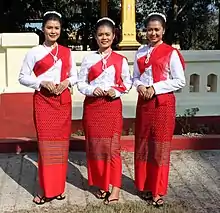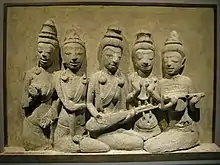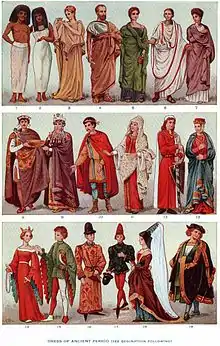Sbai
Sbai or Sabai; (Khmer: ស្បៃ, Sbai, Lao: ສະໄບ, Malay: Sebai; Jawi: سباي, Thai: สไบ, RTGS: sabai, pronounced [sābāj]);, or phaa biang (Lao: ຜ້າບ່ຽງ; Thai: ผ้าเบี่ยง, pronounced [pʰâː bìa̯ŋ]) is a shawl-like garment, or breast cloth worn in mainland Southeast Asia. Sabai is a woman's silk breast wrapper in Cambodia, Laos, and Thailand while in coastal Sumatra and Malay peninsula, the same term is used to described as a shoulder cloth.[1]:410 The sabai was derived from the Indian sari, the end of which is worn over one shoulder.[1]:153
Etymology
Sbai (ស្បៃ) is a Khmer word that refers to any kind of thin and soft garment.[2] In clothing, it specifically refers to shawl-like garment or breast cloth used mostly by women[3][4] and to the lesser extent religious men.[5] While the term sabai is used by Thai which derived from Khmer word (sbai) that refers to the same shawl-like garment.[6][4][7]
History
Sbai is derived from the Indian sari which may have been introduced to Southeast Asia through the Indianized Kingdoms along with other traditions and elements of Indian culture.[1]:153
Cambodia
The sbai of Cambodia was probably introduced from ancient India as it resembles Indian sari. There are related mythologies in the Khmer culture concerning the history of sbai, which was likely introduced during the Kingdom of Funan alongside chang kben in the first century AD. The sbai is mentioned in the legends of Preah Thong and Neang Neak. In one scene, Preah Thong clings to a piece of cloth worn on the Nagini in order to make the journey to the Nāga's kingdom; that piece of cloth is a sbai. In that tale, the sbai is symbolic of the tail of Neang Neak, the Naga princess.[8][9]
During the Kingdom of Chenla, the ladies-in-waiting of the palace were known to wear a shawl-like sbai over the left shoulder to cover the breast and stomach in Buddhist manner. Royal women wore a sava, a loosely decorated band of beads worn crosswise.[10]
In Angkorian period, although it was common for men and women to be topless, however clothes for the upper body were worn: the bas reliefs of Bayon, Preah Khan, and other Angkorian temples depict women wearing a shawl-like sbai while religious male figures are adorned with stylized sbai.[11][12] At Angkor Wat, there are depictions of topless Apsaras holding sbai connected to their sampot, while the northern wall of Angkor Wat depicts a group of ladies wearing long sbai holding various offerings.[13]
For men, especially Brahmin and Buddhist monk, the sbai called sbong sbai trai chivor,[5] and is considered the robe of Hindu and Buddhist monks.[14] For women, sbai can be freely used and in different ways such as to wrapping it around the body, covering the shoulder, and commonly covering the breast and stomach over the left shoulder. Different styles of sbai are used by Cambodian women based on their preferences and traditions.[15]
Nowadays, sbai along with chang kben and sampot are regarded as Cambodia national costume.[3] Sbai most often used in traditional Khmer weddings with different type and decoration during the rite of Preah Thong Taong Sbai Neang Neak (transl. Preah Thong holding on to the sbai of Neang Neak) which represents the legend of the foundation of Funan and where the groom holds on to the bride's sbai as they go to their room. The groom also wears a sbai.[16][17][18]
 Figures wearing sbai depicted on Bayon temple
Figures wearing sbai depicted on Bayon temple Figures wearing stylised sbai depicted on Angkorian temples.
Figures wearing stylised sbai depicted on Angkorian temples. Group of ladies wearing long sbai depicted on northern gallery of Angkor Wat, compared with an artist's drawing
Group of ladies wearing long sbai depicted on northern gallery of Angkor Wat, compared with an artist's drawing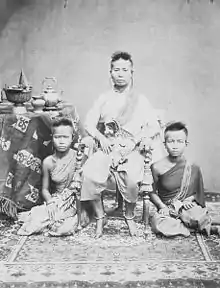 Queen Ang Mey and her daughters wearing sbai in the 1800s
Queen Ang Mey and her daughters wearing sbai in the 1800s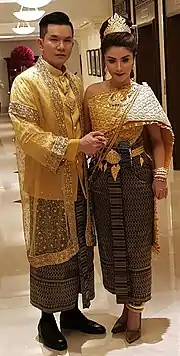 Cambodian bride wearing a sbai in the wedding ceremony
Cambodian bride wearing a sbai in the wedding ceremony.jpg.webp) Dancer wearing sbai
Dancer wearing sbai Different styles of wrapping ''sbai'' used in Cambodia
Different styles of wrapping ''sbai'' used in Cambodia
Laos

In Laos, this garment is known as phaa biang or sabai. It is common for Lao women to wear sabai as it is considered traditional clothing. A sabai can also be worn by men in weddings or when attending religious ceremonies. The type of sabai typically worn by Lao men often has checkered patterns. Sabai can also be a long piece of silk, about a foot wide, that is draped diagonally over the chest covering one shoulder with one end dropping behind the back.[19]
Malaysia
In Malaysia, Sebai is a cloth wrapped around the neck to cover the shoulders with both ends hanging on the chest similar to a scarf hung over the shoulders.[20]
Myanmar
The ethnic Mon is also known to have similar tradition of wearing the shawl-like sabai called Yat Toot in Mon language, diagonally over the chest covering one shoulder with one end dropping behind the back like that worn by Lao women. This tradition distinguished them from other ethnic groups in Myanmar. The today Mon people of Myanmar and Thailand were the descendants of various Indianized polities notably Dvaravati.[21][22] Artifacts from Mon Dvaravati sites in what is now Thailand depicted a group of ladies wearing what is similar to sabai.[23]
Thailand
Sabai (Thai: สไบ, RTGS: sabai, pronounced [sābāj]) or pha biang (Thai: ผ้าเบี่ยง pronounced [pʰâː.bìaŋ]) is shawl-like garment, or breast cloth. Sabais can be used by women or men. The sabai is also known as a long piece of silk, about a foot wide, draped diagonally around the chest by covering one shoulder which its end drops behind the back. Sabais could be worn around the naked chest or on top of another cloth. The practice of wearing Sabai along with Victorian cloth was a common practice during the reign of King Chulalongkorn and lasted until the reign of King Vajiravudh when Westernized clothing became more fashionable. The wearing of sabais as daily wear was officially banned by Plaek Pibulsonggram during Thailand's clothing reform.
Archaeological evidence from Mon Dvaravati site in Thailand depicts five ladies playing instruments and wearing what seems to be a piece of fabric hanging from their shoulder which is quite similar to sabai,[23] but in Mon tradition, this garment is called Yat Toot.

See also
References
- Maxwell, Robyn J.; Gittinger, Mattiebelle (2003). Textiles of Southeast Asia: Tradition, Trade and Transformation. Periplus Editions. ISBN 9780794601041.
- Chuon Nath Khmer Dictionary. 1966, Buddhist Institute, Phnom Penh
- Books, Better World. "Buy New & Used Books Online with Free Shipping". Better World Books. Retrieved 2020-02-24.
- "สไบ - Thai / English dictionary meaning - สไบ ภาษาอังกฤษ แปล ความหมาย". www.thai2english.com. Retrieved 2020-03-09.
- "លក្ខណៈពិសេសនៃពណ៌ស្បង់ចីវររបស់ព្រះសង្ឃពុទ្ធសាសនា". Radio Free Asia (in Khmer). 2015-01-21. Retrieved 2019-09-07.
- "สไบ - Wiktionary". en.wiktionary.org. Retrieved 2020-03-09.
- "Category:Thai terms borrowed from Khmer - Wiktionary". en.wiktionary.org. Retrieved 2020-03-09.
- "Custom & Tradition". www.cambodiancommunityday.org. Retrieved 2020-03-09.
- Nadeem, Zuha (2019-10-01). "Traditional Thai Clothing-16 Beautiful Outfits From Thailand". Outfit Trends - Ideas How to Wear & What to Wear. Retrieved 2020-03-09.
- "Cambodian clothing styles by period Khmer clothing". Cambodian clothing styles by period Khmer clothing. Retrieved 2020-03-09.
- Ferrick, Maine (2019-09-07), English: Female sbai depicted on temple wall at Angkor, retrieved 2020-03-09
- Ferrick, Maine (2019-09-07), English: Angkorian male depictions wearing Sbai Chivor, retrieved 2020-03-09
- "File:Khmer Long Sbai.jpg", Wikipedia, retrieved 2020-03-06
- "Civara, aka: Cīvara; 10 Definition(s)". Wisdom Library. 2009-04-11. Retrieved 2019-09-07.
- Sophorn, Chan (2019-09-16), English: Various styles of Sbai or breast clothes were worn by Khmer women, retrieved 2020-03-09
- Khmer Traditional Wedding
- Ingram, Maria (June 15, 2019). "Payday loans California -Request a loan in minutes via instant cash lenders".
- Nadeem, Zuha (2019-10-01). "Traditional Thai Clothing-16 Beautiful Outfits From Thailand". Outfit Trends - Ideas How to Wear & What to Wear. Retrieved 2020-03-06.
- Bonnie Ghazarbekian, Jane Siegel, Sawaddi, 15 years, p.130.
- "Carian Umum - Sebai". prpm.dbp.gov.my (in Malay). Retrieved 2020-11-15.
- "Mon people", Wikipedia, 2020-02-14, retrieved 2020-03-07
- "Mon kingdoms", Wikipedia, 2019-11-17, retrieved 2020-03-07
- http://www.chatnirun.com/wp-content/uploads/2011/09/Poon1.jpg
External link
![]() Media related to Sbai at Wikimedia Commons
Media related to Sbai at Wikimedia Commons
